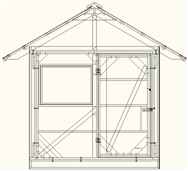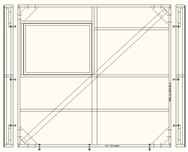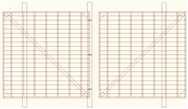Home Site Map - Techniques - Plot Infrastructure -
Shed Building
![]() A
shed may not live forever, but you can still build it right by
following this design.
A
shed may not live forever, but you can still build it right by
following this design.
Sometimes a shed is needed
While you are building your house you will need somewhere to keep your tools and where you can work on the various components out of the rain. What's needed is a simple cheap and quick to build wooden shed. In my area the planning rules allow me to build a shed that is up to 200 square feet (with a 2 foot roof overhang) without applying for planning permission. My design is for a shed that has outside dimensions of 20 feet x 10 feet and a roof footprint of 24 feet x 14 feet.
My design is modular so that I can initially use the shed on the house build site and then later move it to a location within the forest for storing forest maintenance tools. Each section is about 10 feet x 10 feet and the sections bolt together with half inch bolts.
All the lumber for the shed came from my forest and was cut on my SawMill.
I used green lumber, ie I did not dry it. In most cases I cut the needed trees down in the morning, cut it straight away on my sawmill, and by the afternoon the planks had been cut, drilled, and fitted to the shed. The lumber is bound to shrink a bit over time, but really all that matters it that it is dimensionally accurate while the shed is being assembled.
Design drawings
End wall panel with a door and window

Two side panels, both with a 4'x3' window

End wall panel with 4'x3' window

Floor panels with foundation planks

Roof trusses viewed from side

Build the floor panels
There is no foundation involved with the shed. It just sits on piles of concrete paving slabs to raise it off the wet ground. As there is no foundation slab it is necessary to have a nice strong wooden floor assembly.
The floor panels have floor joist lumber 16" on center to make a well supported floor. The underside of the floor sections are wrapped with Tyvek house wrap . The top surface (the warm side, directly under the floor boards) is covered in 6 mil polyethylene sheet . It is important not to use polyethylene sheet on both sides because you need water vapor to escape as the wood dries. The assembly needs to be able to breath rather than being a vapor sandwich. Tyvek is designed with lots of microscopic pores so that it keeps liquid water out and yet allows water in vapor form to pass through.
The picture above (and the one directly below) shows the floor section up-side-down for the fitting of the Tyvek.
After the Tyvek has been added then the assembly is turned right-side-up and the polyethylene sheet is added. You can see the first couple of floor boards resting in place.
Ideally you would add insulation to the floor (eg polystyrene sheets) between the joists prior to covering with the polyethylene sheet, but insulation is expensive and may not be justified for just a shed. The trapped air between the Tyvek on the bottom and the polyethylene on the top will provide some insulation qualities but its effectiveness if not that great because the air is able to move about with convection (insulation such as polystyrene holds the air still because it is trapped in the polystyrene beads so heat is not transferred via convection).
Two floor panels (each 9' 11" x 9' 11-1/2") are needed to form the shed floor. They are bolted together after one panel has had its polyethylene sheet added but with the joining edge not stapled. Initially bolt them together with a half inch gap between the panels so you can get the polyethylene sheet poked down between the panels. The polyethylene sheet for the second floor panel will be completely unstapled so it can be folded back to give access to the bolts. Tighten the bolts to grip the polyethylene sheet in place. Once the two panels are tightly bolted then the polyethylene sheet on the second panel can be stapled.
The following two pictures show a whole bunch of floor boards resting in place on one of the floor assemblies. The floor planks are 1.5" thick. The other floor assembly has not yet had the polyethylene sheet fitted. Note the half inch gap between the floor panels.
Bolts are fitted pointing upwards to connect the walls. The positions need to be accurate as per the drawings. The bolt holes drilled in the floor planks are a tight interference fit so they hold in place even without nuts.
The floor assembly (consisting of two floor panels bolted together need to be placed on site at the required place and supported by paving slabs to keep the wooden floor away from any wet ground. You will want to have 9 stacks of paving slabs to make a nice stable floor. Use a self leveling laser to get the floor level (adding paving slabs and wooden shims as needed to achieve this). A car jack is a good way to jack up the floor so you can add paving slabs and shims.
Build the wall sections
No sheets of OSB or plywood are used on the walls, which is typically what is used to hold wall panels square. Instead a piece of 2x4 lumber is used to provide the necessary triangulation to hold the panel square, ie to stop it skewing.
Some panels may have framing for window openings (see drawings).
The wall panels are then initially fitted to ensure all the bolt holes line up. Note that additional horizontal pieces have been added to the panels to provide additional attachment for the siding and on the inside for eg drywall (if required).
Before the wall panels are finally fitted they need to be wrapped in Tyvek.
Then clad the walls on the outside using lumber cut to a thickness of half an inch. It is perfectly ok and the most efficient on wood usage) to make the panels a variable width, ie whatever the tree yields. These plans are 9' long to also cover the edge of the floor (shorter when there's a window). They attach using 1-1/4" galvanized screws.
Roof trusses
The six roof trusses are made individually and then bolt on to the walls to span between the side walls.


Once the trusses are all bolted on and the two lengths of ridge beam have been fitted, then additional 12 foot lengths of 2-by lumber can be used to fully clad the roof. If this has not yet been done then a tarpaulin can be stretched over the trusses to make the shed temporarily waterproof.
Door
The shed door is really just another wall panel, ie it is also 6 thick. Instead of being bolted in place it is fitted with good strong hinges. It can be clad using the 1/2" thick wooden cladding strips, but I chose to use 1-1/2" planks because I wanted to make it representative of the doors I plan to implement on the main house. The reason for the doors having a 6" thick cavity is that they will have insulation fitted.
With such a heavy door it is necessary to use good string hinges.
There is a 1-1/2" lip on the door edges that mates with an opposite lip on the door frame so that weatherstrip can be fitted to make it an air tight fit.
Porch
A shed on the build site is great for storing tools etc, but it is not the best place to do sawing of wood because of the dust that is created. It is good to implement an outside covered area to do this try of dust generating work. An additional wooden floor was built and then thin wooden strips were used to support another tarp to keep the rain off.



